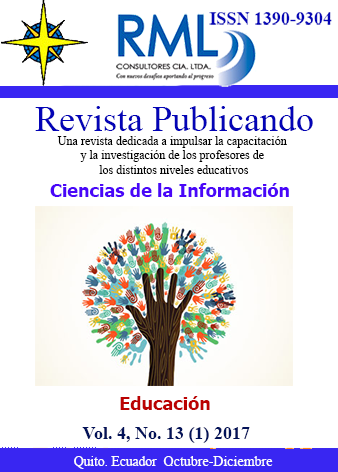Abstract
The article presents the results of scientific research dedicated to the development of students”™ information competence via IT. According to the Federal state educational standard for Higher education development of students”™ information competence is of primary importance.
The article specifies the content and structure of «student”™s information competence »; determines the objective, content and structure of the study course “Information technology”. The didactic support aimed at forming students”™ information competence via IT was developed and tested.
Grade-rating system was used to monitor the results of students”™ formative and summative assessment in 2015-2017. The average grade in control group was 76, the average grade of the experimental group was 84. The analysis of students”™ information competence formation in both groups showed that the students of experimental group demonstrated a higher level of information competence (average and high). Due to student”™s active participation in the learning process the experimental group showed increase in inner motivation. Research results broaden theoretical framework of IT application in the process of students”™ information competence formation. They can be implemented for teaching IT providing control of students”™ information competence formation.
References
Batrova, N., Danilov, A., Lukoyanova, M., Khusainova, A. 2014.Web 2.0 for collaborative work and effective management of a virtual community / N. Batrova, A. Danilov, M. Lukoyanova, A. Khusainova // INTED2014.Proceedings. pp. 5622-5629.
Dubovitskaja, Т.D. 2002.Matodika diagnostiki napravlennosti uchebnoi mmotivazii / Т.D. Dubovitskaja // Psihologicheskaya nauka i obrazovanie. â„–2. – S. 42-45.
Federalnij zakon 2016. «Ob obrazovanii v Rossiskoi Fderazii..N 273-ФЗ ot 29.12.2012Ñ i izmenenijami 2016-2017 goda, URL: http://zakon-ob-obrazovanii.ru
Fuentes Agusti M. , Brando-Garrido C. 2016.Interdisciplinary analysis of the information and communications technology contributions in the use of the student learning portfolio in higher education / // EDULEARN 2016 Proceedings. pp. 6164-6171.
Lukoyanova, M., Khusainova, A.2016. The improvement of the information technology training efficiency for students of humanities / M. Lukoyanova, A. Khusainova // INTED2016 Proceedings. pp. 7459-7465.
Novikov, D.Ð. 2004.Statisticheskie metodi v pedagogicheskih issledovanijah / D.Ð. Novikov. – Ðœ.: ÐœZ–Press, 67 s.
Reyes, G., Gabb, R.2015. Using ICT in a problem-based learning approach: a student and teacher perspective, pp. 111-121, URL: http://link.springer.com/chapter/10.1007/0-387-25997-X_13#
Turbovskoi, Y.S.1993. Vzaimodeistvie pedagogicheskoi nauki I practiki: diagnosticheskii aspeckt. М., 194 s.
Voinova, N.Ð. 2004.Osobennosti formirovania informazionnoi kompetentnosti studentov vuza / N.Ð. Voinova, Ð.V. Voinov // Innovazii v obrazovanii. â„– 4. – S. 111-119.
Zaripova, R.R.2016. Interactive WEB 2.0. Tools in Content and Language Integrated Learning (CLIL) / R.R. Zaripova, L.L. Salekhova, A.V. Danilov // Journal of Language and Literature. Vol. 7. - â„– 3. - P. 65-69.
You are free to:
Share — copy and redistribute the material in any medium or format.
Adapt — remix, transform, and build upon the material.
The licensor cannot revoke these freedoms as long as you follow the license terms.
Under the following terms:
Attribution — You must give appropriate credit, provide a link to the license, and indicate if changes were made. You may do so in any reasonable manner, but not in any way that suggests the licensor endorses you or your use.
NonCommercial — You may not use the material for commercial purposes.
ShareAlike — If you remix, transform, or build upon the material, you must distribute your contributions under the same license as the original.
No additional restrictions — You may not apply legal terms or technological measures that legally restrict others from doing anything the license permits.
